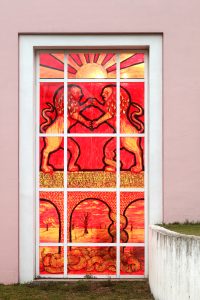
In one of the glass-painted windows of Assi Meshullam’s Vitraji Vulgarum, a doubled Lion of Judah — modeled after the Israeli municipal emblem for the city of Jerusalem — sits over a barren landscape of burnt trees. At the bottom lies a knotted and coiled serpent winding up the pillars of an ancient aqueduct. This Jerusalem does not signify, at first glance, the ir ha’kodesh, the holy city; after all, the Jerusalem in Meshullam’s window is where the serpent was banished, so it seems. And yet, in a certain phase, in a certain dimension, from a certain regard, this barren Jerusalem may also be the holy city. The blazing lions are an unavoidable icon and reference. They are shorn of the official emblem’s olive branches of peace and their doubling produces an internal battle of beasts. It is an other Jerusalem.
As Jewish mobs chant “Death to Arabs” through its streets, as Jewish settlers and the state collude to violently dispossess Palestinian families from Sheikh Jarrah and Silwan, as Israeli forces terrorize innocent Palestinian worshippers on the Temple Mount (Haram al-Sharif), one cannot help but wonder if we have passed into a Jerusalem of the other side, a fiery red landscape of destruction framed by a claim of continuity with the Kingdom of Judah.
In the Zoharic tradition — and there are others — the sitra achra (lit. the other side) does not so much signify an opposite demonic universe, an inverse world rooted in an autonomous Evil, but rather an emanation from the left side of God. It is an emanation that corresponds to Yaakov’s brother Esav and originates from an excess of the supernal emanation of gevurah (i.e. the emanation of severity, judgement) — corresponding to their father Yitzchok.
As a side, an other side, it marks a location, both cosmic and terrestrial, that is indispensably a part of the greater whole of creation and existence. The sitra achra is, as Gershom Scholem reminded, “relative…an entity that has been usurped to the wrong place, but that would be good in its rightful place.” It is the terrain on which the primordial sparks of light are concealed within thick husks; so too, it is the terrain on which we must retrieve these sparks, risking contamination, defilement, depravation, and death.
This issue does not offer a critical exploration of the sitra achra exclusively in its home discourse of rabbinic theology and mysticism but rather asks how the sitra achra might provide a generative terrain for (re)thinking contemporary Jewish politics, culture, and affect beyond reductive moral binaries and defensive postures of ressentiment. It is an opportunity to eschew innocence and purity and ask instead about our multifaceted implication in forms of usurpation, concealment, darkness, and violence.
Tomer Dreyfus translates the poetry of Mascha Kaléko, composed from within the Third Reich; Joshua Simon interviews Liat Berdugo on the weaponized camera and the political limits of the photograph; Zoe Kurland interrogates the sumptuous and lush antisemitic iconography in Rosabel Rosalind’s paintings; Almút Sh. Bruckstein draws on Jalal Toufic to locate and rework a hijacked Talmudic tradition; Danielle Durchslag’s original embroidered textile questions the convergence of Jewish and postfascist ideologies of renewal and return; and much more. Enjoy!